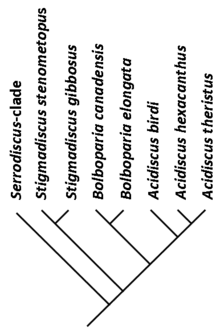Acidiscus
| Acidiscus Temporal range: Botomian (Olenellus-zone) | |
|---|---|
 | |
| Acidiscus birdi | |
| Scientific classification | |
| Kingdom: | Animalia |
| Phylum: | Arthropoda |
| Class: | Trilobita |
| Order: | Agnostida |
| Family: | Weymouthiidae |
| Genus: | Acidiscus Rasetti, 1966 |
| Type species | |
| Acidiscus birdi | |
| species | |
Acidiscus is an extinct genus of eodiscinid agnostid trilobites. It lived during the Botomian stage of the Cambrian period.[2]
Etymology
A. birdi is named for Dr. John M. Bird who collected the holotype.[1] A. hexacanthus is derived from the Greek hexa "six" and acanthos "spine", for having two pairs of border spines in addition to one pair of genal spines.
Taxonomy
Acidiscus is most closely related to Bolboparia and slightly more distantly to Stigmadiscus.
Distribution
A. birdi is known from the Lower Cambrian of the United States (unnamed formation, East Chatham Quad, Columbia County, New York State 42°24′N 73°30′W / 42.400°N 73.500°W),[5] Canada (Newfoundland) and England (Purley Shales of Warwickshire).[6]
Ecology
A. birdi occurs in association with other Weymouthiidae (Acimetopus, Analox, Bathydiscus, Bolboparia, Leptochilodiscus, Serrodiscus), Calodiscus, several species of Olenellus, and Bonnia (Dorypygidae).[5]
Description
Like all Agnostida, Acidiscus is diminutive and the headshield (or cephalon) and tailshield (or pygidium) are of approximately the same size (or isopygous) and outline. Like all Weymouthiidae, it lacks eyes and rupture lines (or sutures). The cephalic border carries one or two pairs of marginal spines. The central raised area of the cephalon (or glabella) does not touch the border furrow, and has two short, pitlike pairs of lateral furrows. Occipital and genal spines are present. Thorax is unknown, but all weymouthiids in which it is known have three segments. The pygidium is much like that in Serrodiscus. The pygidial axis has ten rings. The areas left and right of the axis, called pleura (or in plural pleurae) are without furrows. The edge of the exoskeleton on the ventral side (or doublure) may be extended into short spines.[6]
References
- 1 2 Rasetti, Franco (1966). "New Lower Cambrian trilobite faunule from the Taconic sequence of New York". Smithsonian Miscellaneous Collections. 148 (9): 1–52.
- 1 2 Sepkoski, Jack (2002). "A compendium of fossil marine animal genera (Trilobita entry)". Bulletins of American Paleontology. 364: 560. Retrieved 12 January 2008.
- ↑ Westrop, S.R.; Landing, E. (2011). "Lower Cambrian (Branchian) eodiscoid trilobites from the lower Brigus Formation, Avalon Peninsula, Newfoundland, Canada". Memoirs of the Association of Australasian Palaeontologists. 42: 209–262.
- ↑ Cotton, T.J.; Fortey, R.A. (2005). "5. Comparative morphology and relationships of the Agnostida". In Koenemann, S. & Jenner, R. Crustacean Issues 16, Crustacea and Arthropod Relationships. Boca Raton: CRC Press.
- 1 2 Paleobiology Database. "East Chatham Quad, unnamed fm., NY (Cambrian of the United States) (trilobite)". Retrieved 19 December 2012.
- 1 2 Whittington, H. B. et al. Part O, Treatise on Invertebrate Paleontology. Revised, Volume 1 – Trilobita – Introduction, Order Agnostida, Order Redlichiida. 1997
